Related Research Articles
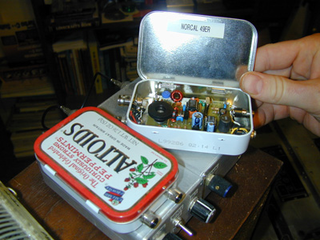
In amateur radio, QRP operation refers to transmitting at reduced power while attempting to maximize one's effective range. QRP operation is a specialized pursuit within the hobby that was first popularized in the early 1920s. QRP operators generally limit their transmitted RF output power to 5 Watts or less regardless of mode be it CW operation or SSB operation.
The Q-code is a standardised collection of three-letter codes that each start with the letter "Q". It is an operating signal initially developed for commercial radiotelegraph communication and later adopted by other radio services, especially amateur radio. To distinguish the use of a Q-code transmitted as a question from the same Q-code transmitted as a statement, operators either prefixed it with the military network question marker "INT" or suffixed it with the standard Morse question mark UD.

Starkville is a city in, and the county seat of, Oktibbeha County, Mississippi, United States. Mississippi State University is a land-grant institution and is located partially in Starkville but primarily in an adjacent unincorporated area designated by the United States Census Bureau as Mississippi State, Mississippi. The population was 25,653 in 2019. Starkville is the most populous city of the Golden Triangle region of Mississippi. The Starkville micropolitan statistical area includes all of Oktibbeha County.
The American Radio Relay League (ARRL) is the largest membership association of amateur radio enthusiasts in the United States. ARRL is a non-profit organization, and was co-founded on April 6, 1914, by Hiram Percy Maxim and Clarence D. Tuska of Hartford, Connecticut. The ARRL represents the interests of amateur radio operators before federal regulatory bodies, provides technical advice and assistance to amateur radio enthusiasts, supports a number of educational programs and sponsors emergency communications service throughout the country. The ARRL has approximately 161,000 members. In addition to members in the US, the organization claims over 7,000 members in other countries. The ARRL publishes many books and a monthly membership journal called QST.

A Hamfest is a convention of amateur radio enthusiasts, often combining a trade show, flea market, and various other activities of interest to amateur radio operators (hams). In the United Kingdom the term rally is more commonly used for amateur radio conventions. "Hamfests" were noted as early as 1924 in the U.S.

The 15-meter band is an amateur radio frequency band spanning the shortwave spectrum from 21 to 21.45 MHz. The band is suitable for amateur long-distance communications, and such use is permitted in nearly all countries.

Contesting is a competitive activity pursued by amateur radio operators. In a contest, an amateur radio station, which may be operated by an individual or a team, seeks to contact as many other amateur radio stations as possible in a given period of time and exchange information. Rules for each competition define the amateur radio bands, the mode of communication that may be used, and the kind of information that must be exchanged. The contacts made during the contest contribute to a score by which stations are ranked. Contest sponsors publish the results in magazines and on web sites.
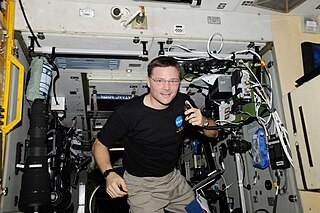
An amateur radio operator is someone who uses equipment at an amateur radio station to engage in two-way personal communications with other amateur operators on radio frequencies assigned to the amateur radio service. Amateur radio operators have been granted an amateur radio license by a governmental regulatory authority after passing an examination on applicable regulations, electronics, radio theory, and radio operation. As a component of their license, amateur radio operators are assigned a call sign that they use to identify themselves during communication. About three million amateur radio operators are currently active worldwide.
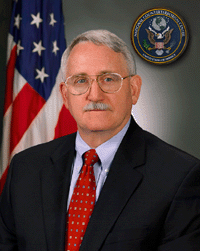
John Scott Redd is a retired vice admiral of the United States Navy, and afterward the first Senate-confirmed Director of the National Counterterrorism Center, serving from 2005 until 2007. According to David Martin at the CBS Evening News, "Scott Redd may be the most important person you've never heard of." J.J. Green at Federal News Radio referred to Redd as "the man that I often call "E.F. Hutton". He is also the past President of the Naval Academy Class of 1966 and has served on the advisory boards of several non-profit organizations. An avid amateur radio operator, Redd has won twelve world championships and nine national championships.

MFJ Enterprises, founded in 1972 by Martin F. Jue, is a manufacturer of a broad range of products for the amateur radio market. They specialize in station accessories, such as antenna tuners and antenna switching equipment. MFJ now manufactures more amateur radio products than any other company in the world.

Vintage amateur radio is a subset of amateur radio hobby where enthusiasts collect, restore, preserve, build, and operate amateur radio equipment from bygone years, such as those using vacuum tube technology. Popular modes of operation include speaking over amplitude modulation (AM), and communicating using Morse code through continuous wave (CW) radiotelegraphy. Some enthusiasts have interest in owning, restoring and operating vintage military and commercial radio equipment such as those from 1940s to 1960s. Some undertake to construct their own gear, known in ham slang as homebrewing, using vintage parts and designs. A number of amateur radio clubs and organizations sponsor contests, events, and swap meets that cater to this specialized aspect of the hobby.
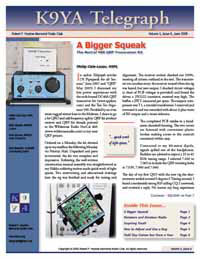
The K9YA Telegraph is a free, monthly, general interest amateur radio e-Zine first published in January 2004. The journal of the Robert F. Heytow Memorial Radio Club, the K9YA Telegraph is distributed to subscribers in over 100 countries via e-mail as a PDF file. Issues comprise original articles written by authors drawn from its subscriber base. Notable among those authors was contributing editor, Rod Newkirk (SK), W9BRD/VA3ZBB, former "How's DX" columnist for QST magazine; Wayne Green (SK), W2NSD, legendary publisher of 73 and other popular electronic hobbyist magazines; and Don Keith, N4KC, best-selling and award-winning author.
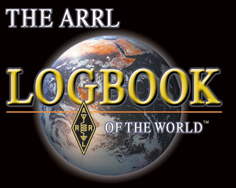
Logbook of the World (LoTW) is a web-accessed database provided by the American Radio Relay League (ARRL) to implement a contact verification service among amateur radio operators. Using LoTW, radio amateurs (hams) can claim and verify contacts (QSOs) made with other amateurs, generally for claiming credit for operating awards, such as DXCC. This kind of verification formerly required exchange of paper QSL cards and submission to ARRL, a slow and somewhat expensive process. LoTW began operation in 2003.
Homebrew is an amateur radio slang term for home-built, noncommercial radio equipment. Design and construction of equipment from first principles is valued by amateur radio hobbyists, known as "hams", for educational value, and to allow experimentation and development of techniques or levels of performance not readily available as commercial products. Some items can be home-brewed at similar or lower cost than purchased equivalents.
Amateur radio or ham radio is practised by more than 22,000 licensed users in India. The first amateur radio operator was licensed in 1921, and by the mid-1930s, there were around 20 amateur radio operators in India. Amateur radio operators played an important part in the Indian independence movement with the establishment of illegal pro-independence radio stations in the 1940s. The three decades after India's independence saw only slow growth in the number of operators until the then Prime Minister of India and amateur radio operator, Rajiv Gandhi (VU2RG), waived the import duty on wireless equipment in 1984. Since then, numbers have picked up, and as of 2007, there were more than 16,000 operators in the country. Amateur radio operators have played a vital role during disasters and national emergencies such as earthquakes, tsunamis, cyclones, floods, and bomb blasts, by providing voluntary emergency communications in the affected areas.
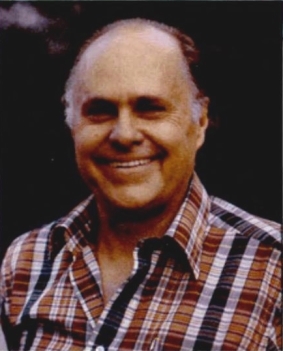
Wayne Sanger Green II was an American publisher, writer, and consultant. Green was editor of CQ magazine before he went on to found 73, 80 Micro, Byte, CD Review, Cold Fusion, Kilobaud Microcomputing, RUN, InCider, and Pico, as well as publishing books and running Instant Software.

Amateur Radio, also known as ham radio, is the use of the radio frequency spectrum for purposes of non-commercial exchange of messages, wireless experimentation, self-training, private recreation, radiosport, contesting, and emergency communications. The term "amateur" is used to specify "a duly authorized person interested in radioelectric practice with a purely personal aim and without pecuniary interest"; and to differentiate it from commercial broadcasting, public safety, or professional two-way radio services.
Amateur radio call signs are allocated to amateur radio operators around the world. The call signs are used to legally identify the station or operator, with some countries requiring the station call sign to always be used and others allowing the operator call sign instead.
Call signs in Korea are unique identifiers for telecommunications and broadcasting on the Korean peninsula. Call signs are regulated internationally by the ITU as well as nationally in South Korea by the Korea Communications Commission in the Ministry of Information and Communication. Not much is known outside of North Korea how amateur radio is regulated, although a foreign amateur was asked to appear before the "Radio Regulation Board" in 2002. Also, North Korea's Cultural Relations with Foreign Countries recently issued an operating permit, which was countermanded by the Ministry of Telecommunications and Posts.
The Yaesu VX series is a line of two sequences of compact amateur radio handheld transceivers produced by Yaesu. There is a line of ultra-compact lower-power dual-band transceivers that started with the VX-1R and was later updated with the VX-2R and VX-3R. There is also a line of 5W tri-band transceivers that started with the VX-5R and was later updated with the VX-6R, VX-7R and VX-8R.
References
- 1 2 Coy, Steve (27 March 2012). "How I Started MFJ and Its Very Early Days" . Retrieved 19 May 2016.
- ↑ "Follow-Up Interview with Martin F. Jue from MFJ Enterprises". 5 March 2010. Retrieved 19 May 2016.
- ↑ "Patents by Inventor Martin F. Jue" . Retrieved 19 May 2016.
- 1 2 "Nine named BCoE Distinguished Alumni Fellows". Mississippi State University. 31 March 2014. Retrieved 19 May 2016.
- 1 2 "MFJ's Martin F. Jue, K5FLU, Honored at ARRL Day in the Park". aarl.org. Aeronautical and Astronautical Research Laboratory. 8 October 2012. Retrieved 19 May 2016.
- ↑ "Jue elected to On2Locate board". 28 February 2010. Retrieved 19 May 2016.
- ↑ "Board Changes, Directions Adopted". Magnolia Radio Intertie. 16 February 2015. Retrieved 19 May 2016.
- ↑ "The CQ Amateur Radio Hall of Fame" (PDF). Retrieved 19 May 2016.
- ↑ "QRP ARCI - Hall Of Fame". QRP Quarterly. QRP Arci. Retrieved 19 May 2016.
- ↑ "Martin F. Jue Receives The Ham Radio Outlet Certificate Of Honor". 30 August 2011. Retrieved 19 May 2016.